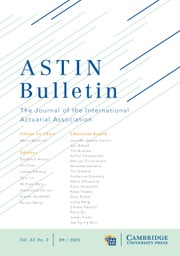Article contents
The Random Walk of a Simple Risk Business
Published online by Cambridge University Press: 29 August 2014
Extract
We suppose that a risk business issues a single type of contract under which, in return for a unit “premium”, it will pay a “sum insured” m (m being an integer) on the occurrence of a contingency of probability q ˂ ½. The expected gain on each contract is i—mq and is assumed to be positive. This type of enterprise is conveniently denominated a simple risk business. Two “real life” situations it simulates are those of a group life policy for a uniform amount covering a number of young lives (e.g., university students), and a roulette casino where the stakes are uniform and the bets are limited to the single numbers o to 36.
The risk business is supposed to commence its operations with a “risk reserve” of K units. Each premium is added to this reserve as it is received and all claims by contract holders are paid there-from. We say that the business is “ruined” as soon as the risk reserve becomes zero or negative (though it could be argued that it would be unethical to accept a premium once the risk reserve is less than m — 1). On the other hand, if the reserve reaches an amount M units no further premiums are paid into it until a claim occurs to reduce it below M (de Finetti, 1957). The risk business intends to continue its operations for a long, but finite, period unless ruined in the meantime.
We consider two probabilities: (i) υx, the chance of eventual ruin given that the risk reserve is now x, and (ii) υx, n, the probability that ruin occurs as a result of the nth contract (simultaneous contracts being ranked in a prearranged, e.g., alphabetical, order). Clearly
and we will write I — νx=μx
Information
- Type
- Papers presented to the ASTIN Colloquium Lucern
- Information
- Copyright
- Copyright © International Actuarial Association 1966
References
REFERENCES
- 5
- Cited by

